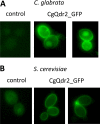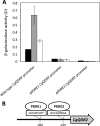Candida glabrata drug:H+ antiporter CgQdr2 confers imidazole drug resistance, being activated by transcription factor CgPdr1
- PMID: 23629708
- PMCID: PMC3697362
- DOI: 10.1128/AAC.00811-12
Candida glabrata drug:H+ antiporter CgQdr2 confers imidazole drug resistance, being activated by transcription factor CgPdr1
Abstract
The widespread emergence of antifungal drug resistance poses a severe clinical problem. Though predicted to play a role in this phenomenon, the drug:H(+) antiporters (DHA) of the major facilitator superfamily have largely escaped characterization in pathogenic yeasts. This work describes the first DHA from the pathogenic yeast Candida glabrata reported to be involved in antifungal drug resistance, the C. glabrata QDR2 (CgQDR2) gene (ORF CAGL0G08624g). The expression of CgQDR2 in C. glabrata was found to confer resistance to the antifungal drugs miconazole, tioconazole, clotrimazole, and ketoconazole. By use of a green fluorescent protein (GFP) fusion, the CgQdr2 protein was found to be targeted to the plasma membrane in C. glabrata. In agreement with these observations, CgQDR2 expression was found to decrease the intracellular accumulation of radiolabeled clotrimazole in C. glabrata and to play a role in the extrusion of this antifungal from preloaded cells. Interestingly, the functional heterologous expression of CgQDR2 in the model yeast Saccharomyces cerevisiae further confirmed the role of this gene as a multidrug resistance determinant: its expression was able to complement the susceptibility phenotype exhibited by its S. cerevisiae homologue, QDR2, in the presence of imidazoles and of the antimalarial and antiarrhythmic drug quinidine. In contrast to the findings reported for Qdr2, CgQdr2 expression does not contribute to the ability of yeast to grow under K(+)-limiting conditions. Interestingly, CgQDR2 transcript levels were seen to be upregulated in C. glabrata cells challenged with clotrimazole or quinidine. This upregulation was found to depend directly on the transcription factor CgPdr1, the major regulator of multidrug resistance in this pathogenic yeast, which has also been found to be a determinant of quinidine and clotrimazole resistance in C. glabrata.
Figures






Similar articles
-
Membrane Proteome-Wide Response to the Antifungal Drug Clotrimazole in Candida glabrata: Role of the Transcription Factor CgPdr1 and the Drug:H+ Antiporters CgTpo1_1 and CgTpo1_2.Mol Cell Proteomics. 2016 Jan;15(1):57-72. doi: 10.1074/mcp.M114.045344. Epub 2015 Oct 28. Mol Cell Proteomics. 2016. PMID: 26512119 Free PMC article.
-
Candida glabrata drug:H+ antiporter CgTpo3 (ORF CAGL0I10384g): role in azole drug resistance and polyamine homeostasis.J Antimicrob Chemother. 2014 Jul;69(7):1767-76. doi: 10.1093/jac/dku044. Epub 2014 Feb 26. J Antimicrob Chemother. 2014. PMID: 24576949
-
STB5 is a negative regulator of azole resistance in Candida glabrata.Antimicrob Agents Chemother. 2013 Feb;57(2):959-67. doi: 10.1128/AAC.01278-12. Epub 2012 Dec 10. Antimicrob Agents Chemother. 2013. PMID: 23229483 Free PMC article.
-
Characterization of the multi-drug efflux systems of pathogenic fungi using functional hyperexpression in Saccharomyces cerevisiae.Nihon Ishinkin Gakkai Zasshi. 2010;51(2):79-86. doi: 10.3314/jjmm.51.79. Nihon Ishinkin Gakkai Zasshi. 2010. PMID: 20467195 Review.
-
Multiple interfaces control activity of the Candida glabrata Pdr1 transcription factor mediating azole drug resistance.Curr Genet. 2019 Feb;65(1):103-108. doi: 10.1007/s00294-018-0870-4. Epub 2018 Jul 28. Curr Genet. 2019. PMID: 30056490 Free PMC article. Review.
Cited by
-
Genomic Data Mining Reveals Abundant Uncharacterized Transporters in Coccidioides immitis and Coccidioides posadasii.J Fungi (Basel). 2022 Oct 10;8(10):1064. doi: 10.3390/jof8101064. J Fungi (Basel). 2022. PMID: 36294626 Free PMC article.
-
Identification of genomic binding sites for Candida glabrata Pdr1 transcription factor in wild-type and ρ0 cells.Antimicrob Agents Chemother. 2014 Nov;58(11):6904-12. doi: 10.1128/AAC.03921-14. Epub 2014 Sep 8. Antimicrob Agents Chemother. 2014. PMID: 25199772 Free PMC article.
-
Genomic evolution towards azole resistance in Candida glabrata clinical isolates unveils the importance of CgHxt4/6/7 in azole accumulation.Commun Biol. 2022 Oct 21;5(1):1118. doi: 10.1038/s42003-022-04087-0. Commun Biol. 2022. PMID: 36271293 Free PMC article.
-
A Transcriptomics Approach To Unveiling the Mechanisms of In Vitro Evolution towards Fluconazole Resistance of a Candida glabrata Clinical Isolate.Antimicrob Agents Chemother. 2018 Dec 21;63(1):e00995-18. doi: 10.1128/AAC.00995-18. Print 2019 Jan. Antimicrob Agents Chemother. 2018. PMID: 30348666 Free PMC article.
-
An Overview on Conventional and Non-Conventional Therapeutic Approaches for the Treatment of Candidiasis and Underlying Resistance Mechanisms in Clinical Strains.J Fungi (Basel). 2020 Feb 10;6(1):23. doi: 10.3390/jof6010023. J Fungi (Basel). 2020. PMID: 32050673 Free PMC article. Review.
References
-
- Jarvis WR. 1995. Epidemiology of nosocomial fungal infections, with emphasis on Candida species. Clin. Infect. Dis. 20:1526–1530 - PubMed
-
- Mishra NN, Prasad T, Sharma N, Payasi A, Prasad R, Gupta DK, Singh R. 2007. Pathogenicity and drug resistance in Candida albicans and other yeast species. A review. Acta Microbiol. Immunol. Hung. 54:201–235 - PubMed
-
- Hayes JD, Wolf CR. (ed). 1997. Modern genetics, vol 3 Molecular genetics of drug resistance. Harwood Academic, Amsterdam, Netherlands
-
- Jungwirth H, Kuchler K. 2006. Yeast ABC transporters—a tale of sex, stress, drugs and aging. FEBS Lett. 580:1131–1138 - PubMed
Publication types
MeSH terms
Substances
LinkOut - more resources
Full Text Sources
Other Literature Sources
Molecular Biology Databases

